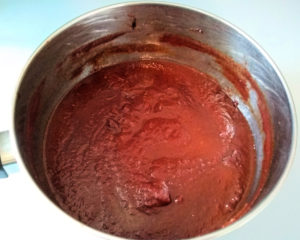Slow-Motion Tomato Ketchup
It’s ironic that most fast food comes with packets of ketchup. When made at home, ketchup is one of the SLOWEST foods imaginable. You fill up a big pot with tomatoes, vinegar, sugar and spices, and after eight? nine? even ten or more hours, all the water will finally have steamed away. What’s left is a fragrant, thick paste that’s bound together with brown sugar. Stick your finger in it and taste it. Yep, that’s ketchup!
At some point of the gardening season, many home canners get sick and tired of the bounty of tomatoes. Once you’ve canned enough halved tomatoes, juice, soups, and sauces (I have enough marinara to get me to the next decade if necessary), and have eaten so many fresh tomatoes you’re starting to wonder if plants will sprout out of your ears… what do you do with the tomatoes that still keep coming?
Make ketchup. You’ll always need it anyway, and after the initial preparation, it just sits on the back burner and s-l-o-w-l-y thickens. I can’t tell you how long it will take, because every tomato variety is different. Romas, Celebrity, and Amish pastes are good varieties for ketchup, since they are more meaty than juicy.
But if you have the patience, any tomato will eventually become ketchup. If you’re using a watery variety, I’d recommend simmering it down a lot before adding the vinegar, sugar and spices. A semi-thick 8 cups of puree is perfect. When you’ve got that, add everything else and keep it simmering on low heat. Eventually, either your toddlers will have graduated college, or you’ll have ketchup. It’s a win/win either way.
I make ketchup with no salt added. You are welcome to add salt if you wish. But, if you’re going to use this on salty French fries, do you really need that extra hit? Think about it before you grab the salt box.
There are slower activities than making ketchup!
The Saint Burchardi Church in the city of Halberstadt started playing “As Slow as Possible” by U.S. composer John Cage in 2001 and the last note change took place in 2013. The church is taking an extreme interpretation of the composition’s title: the piece is expected to last 639 years, coming to a painfully slow end in 2640.
Ingredients
8 cups tomato puree
1/2 cup brown sugar
3/4 cup white vinegar
1 tsp onion powder
1/2 tsp garlic powder
1/8 tsp celery powder
1/8 tsp mustard powder
1/4 tsp pepper
1/8 tsp ground cloves or 2 whole cloves, but be sure to remove them after simmering,
Instructions
Start with fresh tomatoes. Wash, blanch and peel, then cut them into quarters and gently squeeze out as many seeds and juice as possible. Put the pulp in a saucepan and simmer it till soft. The juice can be strained and added back to the pulp, if you wish, but it will increase the overall simmering time. If you have the time, it’s just that much more tomato flavor, though. Or, just save it aside for other uses. When the tomatoes are cooked through and soft, press them through a sieve to remove the rest of the seeds and smooth out the texture. You might have a time-saving device to accomplish this – I have a sieve. 🙂
Warm the tomato puree in a large saucepan or crockpot.
When the puree is warm, stir in all the other ingredients until well blended. (Note: if your puree is very watery, simmer away a lot of the water first, then measure out 8 cups and add the rest of the ingredients to that.)
Continue to simmer the puree on very low heat. Stir often. The goal is to remove all the excess liquid, while giving the ingredients time and heat to blend and mellow. Simmering will take a long time. It all depends on how watery your tomato puree was to start with. You’ll know when it’s ready by its consistency. When it’s as thick as ketchup – you’re done!
Ketchup can be frozen. If you keep it in the fridge, store it in a glass jar to avoid a potential bad reaction between tomatoes and plastic.
If you wish to can your ketchup, pour it into clean pint jars, and add two teaspoons of lemon juice per jar. Leave 1″ head space. Remove bubbles, add hot lids and screw on rings. Process in a boiling water bath for 15 minutes.


